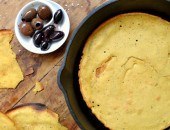Socca

I discovered socca shortly after I had my daughter in 2010, and it immediately became one of my favorite quick, family meals when I was strapped for time or had a fussy baby on my hands. Socca, commonly sold by street vendors in the south of France, is a flatbread made with chickpea flour and is sort of a cross between a crepe and a pancake.

Socca is best enjoyed hot right out of the oven: soft and chewy in the middle, crispy around the edges and underneath, with a slick of olive oil on top and lots of pepper. In addition to being delicious and mildly (OK, wildly) addictive, it’s naturally gluten-free, vegan and rich in protein and fiber.
Although it can be served as a snack, I like to feature it as the base of a casual meal, paired with tapenade, cheese, olives and other no-fuss finger foods that can be enjoyed harmoniously with and alongside it.

I’ve hosted two informal dinner parties with socca as the main event. Everyone lingered around the kitchen table for the better part of the evening – sipping cold rosé, the classic socca pairing– while I hopped over to the oven every 15 minutes or so to pour more batter into a hot cast-iron skillet.



Last year, I brought a large bowl of socca batter to a neighborhood get-together, and my friends and I took turns manning the oven, baking the socca and distributing it to guests throughout the party. Socca, because it’s traditionally broken into pieces or sliced in wedges, begs to be shared with friends.

I’ve heard rumblings on the internet that socca has to be made this way (not too thin!) or that way (not too thick!), and while I understand wanting to serve a dish in its most authentic form, I can tell you regardless of how soft or crispy, thin or thick the socca has turned out, I’ve never heard a complaint.

My friend, Christophe, who is from Nice, introduced me to socca and says the key is to 1) eat it as soon as it comes out of the oven and 2) be generous with the olive oil and pepper. He’s a smart man, and I follow his advice.

For something with so few ingredients – chickpea flour, olive oil, water, salt and pepper – socca truly is a wonderful thing.


SOCCA
The original recipe yields one crepe. However, I use a slightly smaller skillet than the one Bittman calls for, so I usually get 2-3 from one batch.
Don’t be afraid to experiment with crepes of varying thickness. I’ve seen socca prepared two different ways here in Birmingham: at Chez Fonfon it’s served thin and rolled up like a crepe, and at Chez Lulu it’s made thicker, crispier and served in pieces.
Today, you see many variations of traditional socca. Bittman’s recipe incorporates fresh rosemary and onions. My friend, Katie, likes to add turmeric and cayenne pepper to hers. You can also bump up the black pepper in this recipe for a spicy kick.
Ingredients:
1 cup chickpea flour (also called garbanzo bean flour)*
1 teaspoon salt + more for garnish
1 teaspoon ground black pepper + more for garnish
1 cup water, lukewarm
4-6 tablespoons olive oil
*Chickpea flour or garbanzo bean flour is often found in the health food aisle at the grocery store. At Whole Foods, it’s stocked in the flour section. Bob’s Red Mill garbanzo bean flour is what I usually buy.
Directions:
Place a medium or large cast-iron skillet (I use a 9-inch skillet) in the oven and preheat oven to 450 degrees F.
In a bowl, whisk together the chickpea flour, salt and pepper. Slowly add the water, whisking until smooth. Stir in 2 tablespoons of olive oil. Cover and let sit while the oven heats. The batter can rest at room temperature up to 12 hours.
When the oven is ready, pour enough olive oil in the skillet (1-2 tablespoons) to generously cover the bottom of the pan. If using an 8- or 9-inch skillet, pour 1/3 to 1/2 the batter into the skillet (depending on thickness preference), tilting the pan around until the batter is evenly distributed.
Bake for 10-12 minutes until the socca is set in the middle and crisp around the edges. Move the pan a few inches away from the broiler, and broil for 2-3 minutes until the top is brown in spots.
Transfer the socca from the pan to a cutting board. Drizzle with olive oil and season with salt and pepper. Break the socca into pieces or slice into wedges with a pizza cutter. Enjoy immediately.
Adapted from Mark Bittman, The New York Times